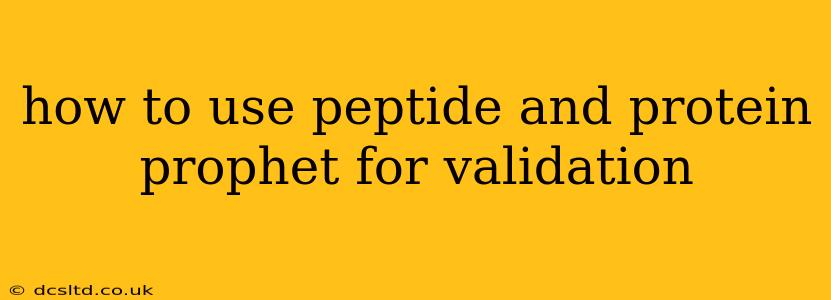PeptideProphet and ProteinProphet are powerful tools used in proteomics to assess the confidence of peptide and protein identifications, respectively. These algorithms are crucial for filtering out false positives and ensuring the reliability of your proteomics data. This guide explains how to use them effectively for validation.
What are PeptideProphet and ProteinProphet?
Before diving into the usage, let's understand their roles:
-
PeptideProphet: This statistical model analyzes the data from peptide identification algorithms (like Mascot, SEQUEST, or OMSSA) to assign probabilities to each identified peptide. It considers various factors, such as the spectral match score, the number of missed cleavages, and the presence of modifications, to determine the likelihood that a given peptide identification is correct. A higher probability indicates a higher confidence in the identification.
-
ProteinProphet: Building upon the results of PeptideProphet, ProteinProphet groups identified peptides into proteins. It then assesses the overall probability that each protein identification is correct, taking into account the number of identified peptides, their probabilities (from PeptideProphet), and the possibility of shared peptides between proteins.
How to Use PeptideProphet and ProteinProphet: A Step-by-Step Guide
The exact implementation depends on your chosen proteomics software pipeline. However, the general workflow usually involves these steps:
-
Peptide Identification: First, you need to identify peptides in your mass spectrometry data using a suitable search engine. This step involves comparing your experimental spectra to a protein database.
-
PeptideProphet Input: The output from the peptide identification search engine (usually in a specific format like .dat or .pep.xml) is then fed into PeptideProphet.
-
PeptideProphet Analysis: PeptideProphet analyzes the data and assigns a probability score to each identified peptide. This probability reflects the confidence in the identification. A common threshold is 0.9, meaning peptides with a probability of 0.9 or higher are considered high-confidence identifications.
-
ProteinProphet Input: The PeptideProphet output (containing peptide probabilities) is then used as input for ProteinProphet.
-
ProteinProphet Analysis: ProteinProphet groups the peptides into proteins and assigns a probability to each protein identification. This reflects the confidence in the protein identification, considering the probabilities of its constituent peptides and accounting for shared peptides. Like PeptideProphet, a common threshold is 0.9.
-
Filtering and Results: Based on the probability thresholds (typically 0.9 for both PeptideProphet and ProteinProphet), you filter the results to retain only high-confidence peptide and protein identifications. The remaining identifications represent the validated part of your proteomics data.
Interpreting PeptideProphet and ProteinProphet Outputs
The outputs typically include probability scores for each peptide and protein. These scores represent the likelihood that the identification is correct. Higher scores indicate higher confidence. Additionally, the outputs often include other information such as:
- Number of peptides per protein: More peptides supporting a protein identification increase confidence.
- Unique peptides per protein: Unique peptides provide stronger evidence than shared peptides.
- False discovery rate (FDR): This metric estimates the proportion of false positive identifications among the reported identifications. Controlling the FDR is crucial for maintaining high data quality.
Frequently Asked Questions (FAQ)
How do I choose the appropriate probability thresholds for PeptideProphet and ProteinProphet?
The choice of thresholds depends on the desired stringency and the specific application. A commonly used threshold is 0.9, which generally provides a good balance between sensitivity and specificity. However, you might need to adjust the thresholds based on the complexity of your sample and the characteristics of your data. Lowering the threshold will increase sensitivity (finding more potential identifications) but increase the risk of false positives.
What if I don't have access to PeptideProphet and ProteinProphet directly?
Many proteomics software packages (like Trans-Proteomic Pipeline (TPP) or MaxQuant) integrate PeptideProphet and ProteinProphet into their workflows. Alternatively, you might find standalone implementations or online tools that provide similar functionality.
What are the limitations of PeptideProphet and ProteinProphet?
While powerful, these tools are not without limitations. They rely heavily on the accuracy of the initial peptide identification step and the quality of the input data. Factors like database completeness, post-translational modifications, and the presence of isoforms can affect the accuracy of the probability scores.
Can I use PeptideProphet and ProteinProphet with all mass spectrometry data types?
While widely applicable, the effectiveness of PeptideProphet and ProteinProphet can vary slightly depending on the specific mass spectrometry techniques used (e.g., DDA vs. DIA). The algorithms are typically optimized for data obtained through data-dependent acquisition (DDA), but adaptations exist for other types.
By carefully using PeptideProphet and ProteinProphet, researchers can substantially enhance the reliability and validity of their proteomics findings, leading to more robust and credible scientific conclusions. Remember that these tools are part of a comprehensive data analysis pipeline and should be used in conjunction with other quality control measures.
